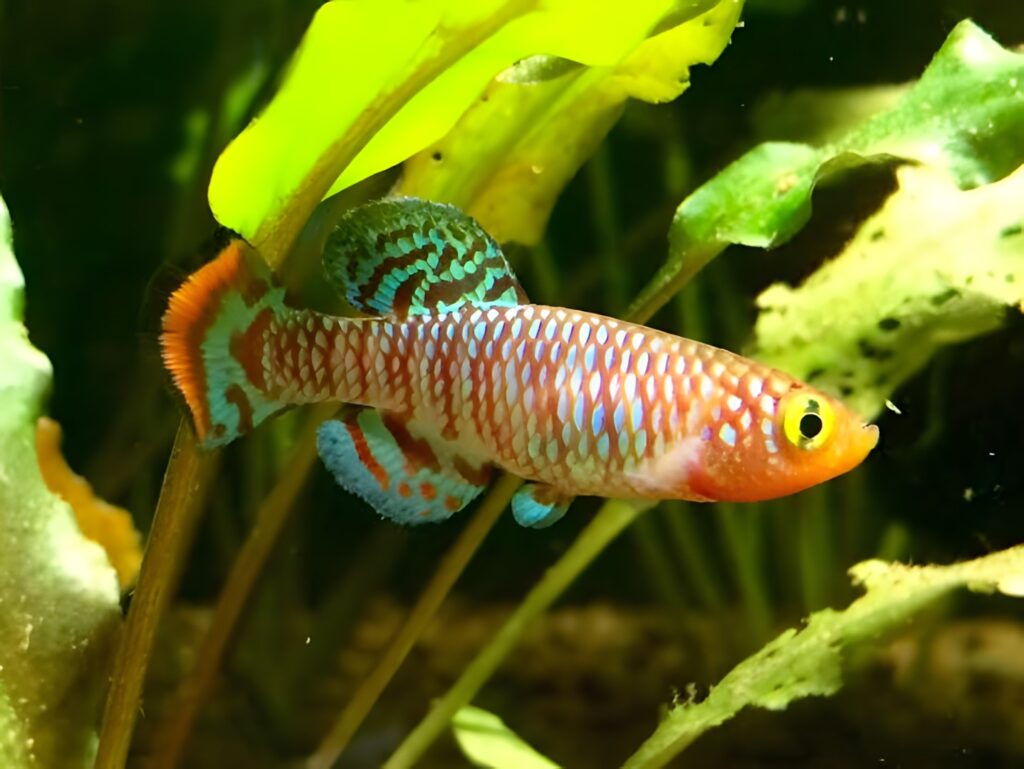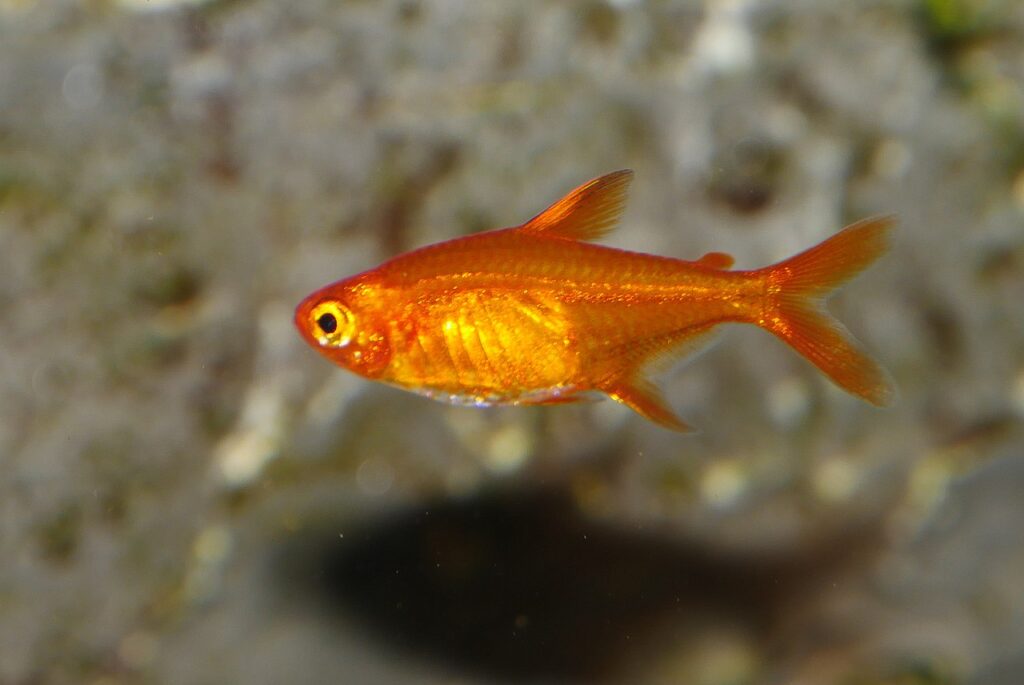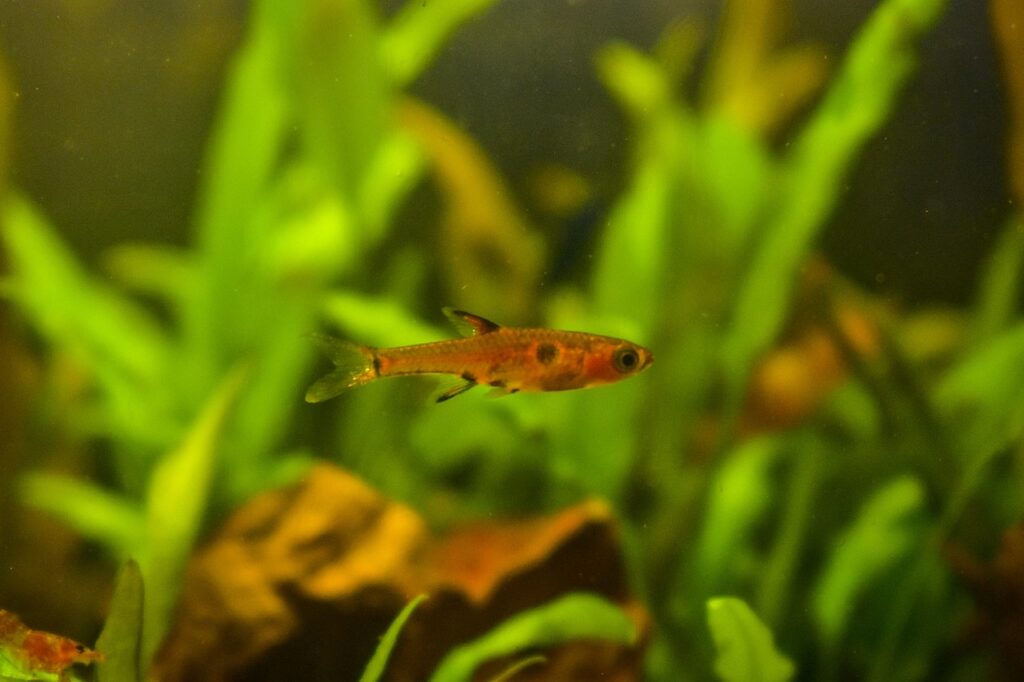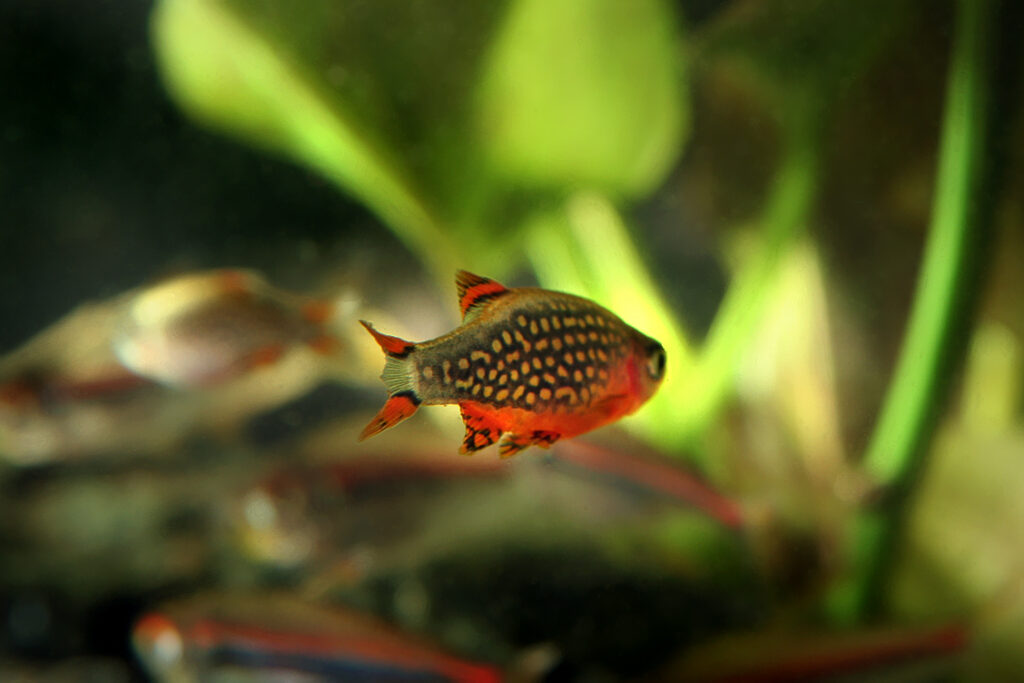The Bluefin Notho Killifish, also referred to as Nothobranchius rachovii, is an intriguing aquatic creature that possesses a captivating allure. Displaying a vibrant array of colors, these enchanting fish are guaranteed to inject a dazzling dose of glamour into your aquarium!
Table of Contents
One interesting fact about Bluefin Nothos is that their eggs can survive dry periods by burrowing into the substrate and going into a state of diapause. The eggs can stay in this dormant state for months until the rains return and the pools refill with water, triggering them to hatch. Amazing!
Nothobranchius rachovii belongs to the killifish family Nothobranchiidae. Their closest relatives include other Nothobranchius species like N. furzeri, the turquoise killifish. Killifish in general are known for their bright colors and many are popular in the aquarium trade.
The species name “rachovii” honors German aquarist Arthur Rachow, who was one of the first to breed and describe this species in 1926 after receiving specimens collected in Beira, Mozambique. The name Nothobranchius comes from Greek and means “false gills”, referring to the lack of a fully developed gill cover in these fish.
In the wild, N. rachovii inhabits temporary pools and flood plains in subtropical regions of East Africa, including Mozambique, Malawi, and Zimbabwe. As bottom-dwellers, they prefer sandy or silty substrates where they can bury their eggs. Bluefin Nothos are micropredators and will eat small aquatic crustaceans, insect larvae, and other zooplankton in nature.
Bluefin Nothos typically grow to a size of 1.5-2.5 inches (4-6 cm) with males being larger and more brightly colored than females. Males have shimmering bluish-green flanks with red and yellow stripes on the fins, while females are more drab. These fish live up to 3 years with proper care.
In the aquarium trade, N. rachovii is sometimes sold under the names Bluefin Notho, Blue Notho, or Rachow’s Notho. It is a popular choice for killifish enthusiasts but is short-lived compared to many other aquarium fish, living only 1-2 years typically.
Bluefin Nothos do best in a species tank but can be kept with other peaceful fish in a well-maintained 10+ gallon aquarium. As they prefer to spawn in the substrate, a layer of sand or fine gravel is recommended. These active fish also appreciate some plants and hiding spots. Filtration and regular water changes are a must to maintain high water quality.
In terms of diet, Bluefin Nothos will accept a variety of small meaty foods like brine shrimp, daphnia, bloodworms, and commercial micropellets. Frequent small feedings are better than infrequent large meals. Be careful not to overfeed as these fish are prone to obesity.
While Nothos have a reputation for being delicate, with pristine water and a proper setup they can thrive. Maintaining stable water parameters is key. They prefer a temperature range of 68-77°F (20-25°C), low organic waste, and a pH of 6.5-7.5. Fluctuations in water quality can quickly lead to issues.
If given good care, Bluefin Nothos may even spawn in the home aquarium! Females scatter their eggs in the substrate where they are fertilized by males. Removing and incubating the eggs in moist peat is the recommended breeding method. Fry are tiny and require infusoria and other microscopic foods initially.

Bluefin Notho Killifish Key Information
The Bluefin Notho Killifish (Nothobranchius rachovii) is a stunning fish that captivates aquarium enthusiasts with its vibrant colors. Males showcase a brilliant bluish-green body adorned with striking red and yellow stripes on their fins, while females exhibit a more subdued appearance. The intensity of these colors can vary depending on the fish’s mood, health, and breeding condition, making them a dynamic and visually appealing addition to any aquarium.
| Family | Nothobranchiidae |
| Origin | East Africa (Mozambique, Malawi, Zimbabwe) |
| Price | Moderate |
| Common Names | Bluefin Notho, Blue Notho, Rachow’s Notho |
| Variants | None |
| Ideal Tank Size | 10+ gallons |
| Water Parameters | Temperature: 68-77°F (20-25°C), pH: 6.5-7.5 |
| Lifespan | 1-3 years |
| Full Size | 1.5-2.5 inches (4-6 cm) |
| Natural Environment | Temporary pools and flood plains |
| Behavior | Active, peaceful |
| Habitat Preference | Bottom-dweller, sandy or silty substrate |
| Aquarium Decoration | Sand or fine gravel substrate, plants, hiding spots |
| Ideal Tank Mates | Other peaceful fish |
| Fish to Avoid | Large, aggressive fish |
| Best Foods/Diet | Brine shrimp, daphnia, bloodworms, micropellets |
| Disease | Prone to diseases if water quality is poor |
| Sex-Switch | No |
| Gender Differences | Males are larger and more colorful than females |
| Care Level | Moderate |
| Breeding Level | Moderate |
Ideal Tank Mates for Bluefin Notho Killifish
When selecting tank mates for Bluefin Notho Killifish, it’s essential to choose species that share similar water parameters, temperament, and habitat preferences. Ideal tank mates should be peaceful, non-aggressive, and adaptable to the relatively short lifespan of Nothos. It’s also crucial to avoid fish that might outcompete or intimidate the Nothos, as well as those that may nip at their delicate fins.
Here are 10 ideal tank mates for Bluefin Notho Killifish, each with unique characteristics that make them compatible companions:
1. Endler’s Livebearer (Poecilia wingei)

Endler’s Livebearers are small, colorful fish that originate from the same geographical region as Bluefin Nothos. Their peaceful nature and similar water requirements make them excellent tank mates. Both species enjoy planted aquariums with plenty of hiding spots, and their active swimming behaviors add visual interest to the tank.
| Common/Market Names | Endler’s Livebearer, Endler’s Guppy |
| Price Range | Low to Moderate |
| Care Level | Easy |
| Behavior | Peaceful, active |
| Life Span | 3-5 years |
| Max Size | 1-1.5 inches (2.5-3.8 cm) |
2. Ember Tetra (Hyphessobrycon amandae)

Ember Tetras are tiny, schooling fish with a striking red-orange coloration that complements the Bluefin Nothos’ vibrant hues. Their peaceful demeanor and preference for the upper levels of the aquarium make them ideal tank mates, as they won’t compete with the bottom-dwelling Nothos for space or resources.
| Common/Market Names | Ember Tetra, Amanda’s Tetra |
| Price Range | Low |
| Care Level | Easy |
| Behavior | Peaceful, schooling |
| Life Span | 2-4 years |
| Max Size | 0.8-1 inch (2-2.5 cm) |
3. Pygmy Corydoras (Corydoras pygmaeus)

Pygmy Corydoras are miniature catfish that share the Bluefin Nothos’ preference for the bottom of the aquarium. Their small size and peaceful nature make them excellent companions, as they won’t outcompete the Nothos for food or territory. Both species enjoy sifting through the substrate for food particles and appreciate a well-planted aquarium.
| Common/Market Names | Pygmy Corydoras, Pygmy Cory |
| Price Range | Low to Moderate |
| Care Level | Easy |
| Behavior | Peaceful, schooling |
| Life Span | 3-5 years |
| Max Size | 1-1.5 inches (2.5-3.8 cm) |
4. Dwarf Rasbora (Boraras maculatus)

Dwarf Rasboras are tiny, schooling fish with a unique spotted pattern that adds visual interest to the aquarium. Their peaceful nature and preference for the middle and upper levels of the tank make them ideal companions for Bluefin Nothos. Both species thrive in well-planted aquariums with gentle filtration and appreciate the company of their own kind.
| Common/Market Names | Dwarf Rasbora, Spotted Rasbora |
| Price Range | Low to Moderate |
| Care Level | Easy to Moderate |
| Behavior | Peaceful, schooling |
| Life Span | 3-5 years |
| Max Size | 0.8-1 inch (2-2.5 cm) |
5. Celestial Pearl Danio (Danio margaritatus)

Celestial Pearl Danios are small, iridescent fish with a mesmerizing spotted pattern that rivals the beauty of the Bluefin Nothos. Their peaceful temperament and adaptability to various water conditions make them excellent tank mates. Both species enjoy a well-planted aquarium with plenty of hiding spots and appreciate the company of their own kind.
| Common/Market Names | Celestial Pearl Danio, Galaxy Rasbora |
| Price Range | Moderate |
| Care Level | Easy to Moderate |
| Behavior | Peaceful, schooling |
| Life Span | 3-5 years |
| Max Size | 1-1.5 inches (2.5-3.8 cm) |
6. Neon Tetra (Paracheirodon innesi)

Neon Tetras are popular aquarium fish known for their striking blue and red coloration. Their peaceful nature and adaptability to a wide range of water conditions make them compatible with Bluefin Nothos. Both species appreciate a well-planted aquarium with subdued lighting and gentle filtration.
| Common/Market Names | Neon Tetra |
| Price Range | Low |
| Care Level | Easy |
| Behavior | Peaceful, schooling |
| Life Span | 5-8 years |
| Max Size | 1.5 inches (3.8 cm) |
7. Dwarf Gourami (Trichogaster lalius)

Dwarf Gouramis are small, colorful labyrinth fish that make excellent tank mates for Bluefin Nothos. Their peaceful temperament and preference for the upper levels of the aquarium ensure minimal competition for space and resources. Both species appreciate a well-planted aquarium with plenty of hiding spots and surface vegetation.
| Common/Market Names | Dwarf Gourami, Dwarf Banded Gourami |
| Price Range | Low to Moderate |
| Care Level | Easy to Moderate |
| Behavior | Generally peaceful |
| Life Span | 3-5 years |
| Max Size | 2-2.5 inches (5-6.3 cm) |
8. Harlequin Rasbora (Trigonostigma heteromorpha)

Harlequin Rasboras are small, schooling fish with a unique triangular shape and striking red and black coloration. Their peaceful nature and adaptability to various water conditions make them compatible with Bluefin Nothos. Both species appreciate a well-planted aquarium with subdued lighting and gentle filtration.
| Common/Market Names | Harlequin Rasbora, Red Rasbora |
| Price Range | Low |
| Care Level | Easy |
| Behavior | Peaceful, schooling |
| Life Span | 5-8 years |
| Max Size | 1.5-2 inches (3.8-5 cm) |
9. White Cloud Mountain Minnow (Tanichthys albonubes)

White Cloud Mountain Minnows are hardy, adaptable fish that thrive in the same cool water conditions as Bluefin Nothos. Their peaceful temperament and active swimming behavior make them engaging tank mates, while their preference for the upper levels of the aquarium ensures minimal competition for space and resources.
| Common/Market Names | White Cloud Mountain Minnow, White Cloud |
| Price Range | Low |
| Care Level | Easy |
| Behavior | Peaceful, schooling |
| Life Span | 3-5 years |
| Max Size | 1.5-2 inches (3.8-5 cm) |
10. Cherry Shrimp (Neocaridina davidi)

Cherry Shrimp are small, colorful invertebrates that make excellent tankmates for Bluefin Nothos. Their peaceful nature and low bioload make them ideal additions to a Notho aquarium, while their scavenging behavior helps maintain a clean and healthy environment. Both species appreciate a well-planted aquarium with plenty of hiding spots and gentle filtration.
| Common/Market Names | Cherry Shrimp, Red Cherry Shrimp |
| Price Range | Low to Moderate |
| Care Level | Easy |
| Behavior | Peaceful, scavenging |
| Life Span | 1-2 years |
| Max Size | 1-1.5 inches (2.5-3.8 cm) |
FAQs about Bluefin Notho Killifish
Here are some frequently asked questions about Bluefin Notho Killifish that cover new topics not previously discussed:
How do I acclimate Bluefin Notho Killifish to my aquarium?
Acclimation is crucial to ensure a smooth transition and minimize stress. Float the bag containing your Nothos in the aquarium for 15-20 minutes to allow the temperature to equalize. Gradually add small amounts of aquarium water to the bag over the next 30-45 minutes. Finally, gently release the fish into the aquarium, taking care not to introduce any bag water.
Can I keep Bluefin Notho Killifish in a planted aquarium?
Absolutely! Bluefin Nothos thrive in well-planted aquariums, as plants provide shelter, improve water quality, and create a more natural environment. Choose hardy, low-light plants like Java Fern, Anubias, and Cryptocoryne species. Ensure the plants are securely rooted to prevent the Nothos from uprooting them when searching for food in the substrate.
How often should I feed my Bluefin Notho Killifish?
Offer small, frequent meals 2-3 times a day. Bluefin Nothos have small stomachs and require a consistent supply of food to maintain their energy levels. Provide a variety of high-quality, protein-rich foods such as live or frozen brine shrimp, daphnia, and bloodworms. Remove any uneaten food after a few minutes to maintain water quality.
How do I prevent my Bluefin Notho Killifish from jumping out of the aquarium?
Bluefin Nothos are known for their jumping abilities, so a tight-fitting aquarium lid is essential. Ensure there are no gaps or openings where the fish can escape. If your aquarium has a hang-on-back filter, consider using a pre-filter sponge or a custom cover to prevent the Nothos from jumping into the filter compartment.
Can I keep Bluefin Notho Killifish with shrimp or snails?
Yes, Bluefin Nothos can be kept with peaceful invertebrates like Cherry Shrimp, Amano Shrimp, and Nerite Snails. These tankmates can help control algae growth and clean up uneaten food. However, keep in mind that adult Nothos may occasionally prey on very small shrimp. Provide plenty of hiding spots and vegetation for the shrimp to minimize this risk.
How can I tell if my Bluefin Notho Killifish are stressed?
Signs of stress in Bluefin Nothos include loss of appetite, lethargy, hiding excessively, rapid breathing, and faded coloration. Stress can be caused by poor water quality, incompatible tankmates, overcrowding, or inadequate nutrition. If you notice any of these signs, test your water parameters, perform a water change, and address any potential stressors.
How do I maintain good water quality in my Bluefin Notho Killifish aquarium?
Regularly perform partial water changes (10-20%) every week to remove accumulated waste and replenish essential minerals. Use a high-quality water conditioner to remove harmful chlorine and chloramines. Monitor water parameters (ammonia, nitrite, nitrate, pH) with a reliable test kit. Avoid overfeeding and overstocking, and maintain efficient filtration to keep the water clean and well-oxygenated.
Can I breed Bluefin Notho Killifish in my home aquarium?
Yes, breeding Bluefin Nothos is possible with proper setup and care. Provide a separate breeding tank with a layer of peat moss or coconut fiber for spawning. Condition the breeding pair with high-quality, protein-rich foods. After spawning, remove the adult fish and keep the substrate moist. The eggs will enter a state of diapause and can be stored until you’re ready to hatch them by rewetting the substrate.